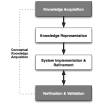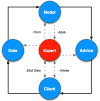Conceptual knowledge acquisition in biomedicine: A methodological review
- PMID: 17482521
- PMCID: PMC2082059
- DOI: 10.1016/j.jbi.2007.03.005
Conceptual knowledge acquisition in biomedicine: A methodological review
Abstract
The use of conceptual knowledge collections or structures within the biomedical domain is pervasive, spanning a variety of applications including controlled terminologies, semantic networks, ontologies, and database schemas. A number of theoretical constructs and practical methods or techniques support the development and evaluation of conceptual knowledge collections. This review will provide an overview of the current state of knowledge concerning conceptual knowledge acquisition, drawing from multiple contributing academic disciplines such as biomedicine, computer science, cognitive science, education, linguistics, semiotics, and psychology. In addition, multiple taxonomic approaches to the description and selection of conceptual knowledge acquisition and evaluation techniques will be proposed in order to partially address the apparent fragmentation of the current literature concerning this domain.
Figures













Similar articles
-
Information retrieval and knowledge discovery utilising a biomedical Semantic Web.Brief Bioinform. 2005 Sep;6(3):252-62. doi: 10.1093/bib/6.3.252. Brief Bioinform. 2005. PMID: 16212773 Review.
-
Text mining and ontologies in biomedicine: making sense of raw text.Brief Bioinform. 2005 Sep;6(3):239-51. doi: 10.1093/bib/6.3.239. Brief Bioinform. 2005. PMID: 16212772 Review.
-
The distinction between linguistic and conceptual semantics in medical terminology and its implication for NLP-based knowledge acquisition.Methods Inf Med. 1998 Nov;37(4-5):327-33. Methods Inf Med. 1998. PMID: 9865030
-
The next generation of literature analysis: integration of genomic analysis into text mining.Brief Bioinform. 2005 Sep;6(3):287-97. doi: 10.1093/bib/6.3.287. Brief Bioinform. 2005. PMID: 16212776 Review.
-
NLP techniques associated with the OpenGALEN ontology for semi-automatic textual extraction of medical knowledge: abstracting and mapping equivalent linguistic and logical constructs.Proc AMIA Symp. 2000:76-80. Proc AMIA Symp. 2000. PMID: 11079848 Free PMC article.
Cited by
-
First-in-human, double-blind, randomized phase 1b study of peptide immunotherapy IMCY-0098 in new-onset type 1 diabetes: an exploratory analysis of immune biomarkers.BMC Med. 2024 Jun 21;22(1):259. doi: 10.1186/s12916-024-03476-y. BMC Med. 2024. PMID: 38902652 Free PMC article. Clinical Trial.
-
Validation of knowledge acquisition for surgical process models.J Am Med Inform Assoc. 2009 Jan-Feb;16(1):72-80. doi: 10.1197/jamia.M2748. Epub 2008 Oct 24. J Am Med Inform Assoc. 2009. PMID: 18952942 Free PMC article.
-
Automatic knowledge-based recognition of low-level tasks in ophthalmological procedures.Int J Comput Assist Radiol Surg. 2013 Jan;8(1):39-49. doi: 10.1007/s11548-012-0685-6. Epub 2012 Apr 19. Int J Comput Assist Radiol Surg. 2013. PMID: 22528057
-
Conceptual Knowledge Discovery in Databases for Drug Combinations Predictions in Malignant Melanoma.Stud Health Technol Inform. 2015;216:663-7. Stud Health Technol Inform. 2015. PMID: 26262134 Free PMC article.
-
Translational informatics: enabling high-throughput research paradigms.Physiol Genomics. 2009 Nov 6;39(3):131-40. doi: 10.1152/physiolgenomics.00050.2009. Epub 2009 Sep 8. Physiol Genomics. 2009. PMID: 19737991 Free PMC article. Review.
References
-
- McCormick R. Conceptual and Procedural Knowledge. International Journal of Technology and Design Education. 1997;7:141–159.
Publication types
MeSH terms
Grants and funding
LinkOut - more resources
Full Text Sources

